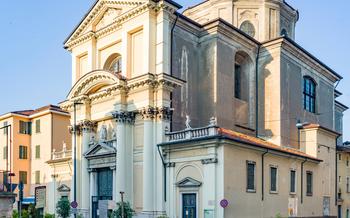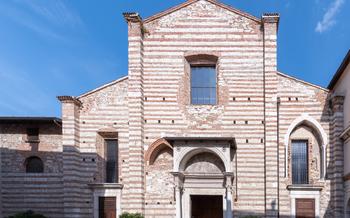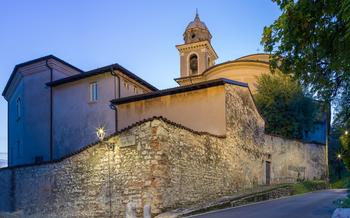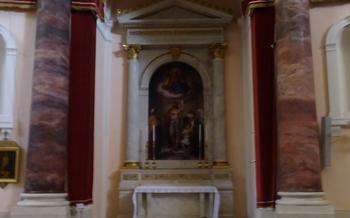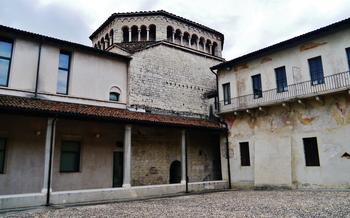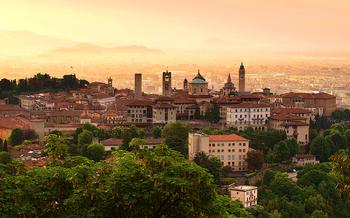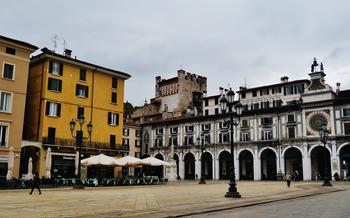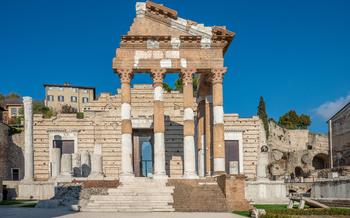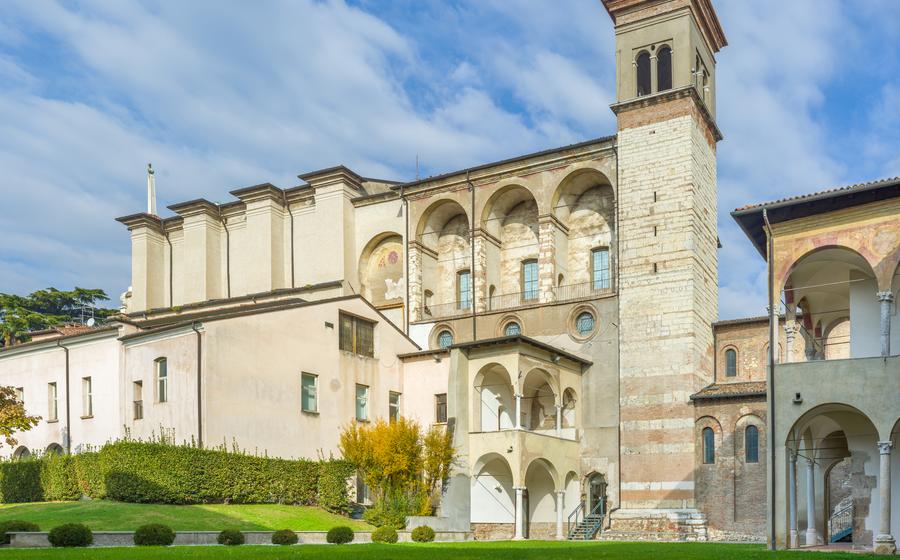
Museo di Santa Giulia
- Introduction - The Allure of Brescia and Museo di Santa Giulia
- Museo di Santa Giulia - A Journey Through Time
- Navigating the Museum - A Comprehensive Guide
- Artistic Masterpieces - A Feast for the Senses
- The Brescia Casket - A Timeless Treasure
- Weapons and Armor: Glimpsing Brescia's Martial Past
- The Nuns' Choir - A Sacred Haven
- The Archaeological Section: Unveiling Brescia's Ancient Roots
- The Monastery Complex - A Journey into History
- Temporary Exhibitions: A Dynamic Showcase of Artistic Expression
- Educational Programs: Engaging with the Past
- Planning Your Visit - Essential Tips for a Rewarding Experience
- Surrounding Attractions - Exploring Brescia's Cultural Treasures
- Insider Tip: Unveiling a Hidden Gem
Introduction - The Allure of Brescia and Museo di Santa Giulia
Nestled in the heart of Lombardy, Brescia, with its rich and captivating history, inviting visitors to uncover the beauty of its artistic and cultural heritage. Among the city's many treasures, the Museo di Santa Giulia stands as a testament to Brescia's enduring legacy. This extraordinary museum, housed within a former monastery complex, unveils the city's storied past through a stunning collection of artworks, artifacts, and historical treasures. As you step into the museum's hallowed halls, prepare to embark on a journey through time, where the echoes of history blend seamlessly with the wonders of artistic expression.
The Museo di Santa Giulia serves as the guardian of Brescia's cultural legacy, preserving and showcasing masterpieces that illuminate the city's artistic and cultural evolution. From ancient Roman artifacts to exquisite medieval sculptures, from Renaissance paintings to contemporary installations, the museum offers a comprehensive exploration of Brescia's artistic heritage. Whether you are an art enthusiast, a history buff, or simply a traveler seeking cultural enrichment, the Museo di Santa Giulia promises an unforgettable experience, leaving you captivated by the timeless allure of Brescia's artistic treasures.
Museo di Santa Giulia - A Journey Through Time
The Museo di Santa Giulia is not just a museum; it is a journey through time, a living testament to Brescia's rich and storied past. Its history is as diverse as the artifacts it houses, spanning from its humble beginnings as a Benedictine monastery in the 8th century to its current status as a cultural landmark of international renown.
The museum complex itself is a testament to the city's architectural evolution, showcasing a harmonious blend of Romanesque, Gothic, and Renaissance styles. Its name has undergone several changes over the centuries, reflecting the shifting tides of history. Initially known as the Monastery of Santa Giulia, it later became the Civic Museum of Christian Art and finally, in 1998, the Museo di Santa Giulia. Each name change marks a new chapter in the museum's story, underscoring its enduring significance as a guardian of Brescia's artistic and cultural heritage.
Navigating the Museum - A Comprehensive Guide
The Museo di Santa Giulia is a labyrinthine complex, comprising diverse sections that narrate the intricate tapestry of Brescia's past. To fully appreciate its treasures, a strategic approach is essential. Begin your journey in the Sala delle Croci, where a concise introduction to the museum's history and layout awaits. Immerse yourself in the Romanesque splendor of the Church of Santa Maria in Solario, a testament to Brescia's enduring architectural heritage.
Proceed to the main exhibition halls, where chronological and thematic displays guide you through the city's artistic evolution. Admire the exquisite collection of paintings, sculptures, and artifacts, spanning from ancient Roman times to the Renaissance and beyond. Don't miss the breathtaking Nuns' Choir, with its ethereal frescoes and intricate carvings, a testament to the artistry and spirituality that permeated monastic life.
For a deeper understanding of Brescia's martial prowess, explore the dedicated section showcasing an impressive array of weapons and armor. Marvel at the intricate craftsmanship and historical significance of these artifacts, which vividly evoke the city's role as a renowned center of arms production.
To delve into Brescia's ancient roots, venture into the archaeological section, where fascinating artifacts from the Bronze Age onward shed light on the city's earliest inhabitants and their way of life. Discover significant archaeological discoveries that have reshaped our understanding of the region's rich history.
Artistic Masterpieces - A Feast for the Senses
The Museo di Santa Giulia boasts an impressive collection of paintings, sculptures, and artifacts that span various artistic periods and genres. Among the highlights are works by renowned artists such as Romanino, Moretto da Brescia, and Giovanni Battista Tiepolo. Romanino's vibrant and expressive paintings, such as the "Deposition," showcase his mastery of color and movement. Moretto da Brescia's works, including the "Madonna and Child with Saints," exemplify the serene beauty and naturalism that characterized the Renaissance period. Giovanni Battista Tiepolo's ceiling frescoes, such as the "Glory of St. Benedict," are renowned for their illusionistic effects and dynamic compositions.
The museum's collection also includes exquisite sculptures from different eras. Notable works include the Roman bronze statue of the "Winged Victory," a symbol of Brescia's ancient heritage, and the medieval wooden sculpture of the "Crucifixion," which displays a remarkable level of detail and emotion. Visitors can also admire a rich collection of artifacts, including ceramics, jewelry, and textiles, that provide glimpses into the daily life and cultural practices of Brescia's inhabitants throughout history.
The artistic treasures housed within the Museo di Santa Giulia offer a captivating journey through the history of art and the diverse cultural influences that have shaped Brescia's artistic heritage. From the vibrant colors of the Renaissance to the ethereal beauty of the Baroque, the museum's collection is a testament to the enduring power of artistic expression.
The Brescia Casket - A Timeless Treasure
Nestled within the Museo di Santa Giulia lies a breathtaking masterpiece of early medieval craftsmanship - the Brescia Casket. This exquisite ivory casket, dating back to the 4th century AD, is renowned for its intricate carvings and symbolic imagery. Its panels depict scenes from the Old and New Testaments, along with mythological figures and animals, showcasing the exceptional skill and artistry of its unknown creator.
The Brescia Casket's intricate iconography invites viewers on a journey through biblical narratives and classical mythology. One panel portrays the Annunciation, where the angel Gabriel delivers God's message to Mary, while another depicts the Adoration of the Magi, capturing the reverence of the wise men as they present their gifts to the infant Jesus. Pagan deities such as Bacchus, the Roman god of wine, and Hercules, the mythical hero, also grace the casket's surface, highlighting the fusion of Christian and classical traditions in early medieval art.
The mystery surrounding the casket's creation adds to its allure. Art historians have meticulously studied the casket, attempting to unravel its origins and intended purpose. Some believe it was commissioned by a wealthy patron as a reliquary, a container for sacred objects, while others speculate that it may have been used as a luxury cosmetic box. Regardless of its original function, the Brescia Casket stands as a testament to the extraordinary craftsmanship and artistic ingenuity of its time.
Weapons and Armor: Glimpsing Brescia's Martial Past
The Museo di Santa Giulia houses an impressive collection of weapons and armor, tracing the evolution of Brescia's martial heritage from ancient times to the Renaissance. Among the highlights are exquisitely crafted swords, helmets, and suits of armor, showcasing the exceptional skill of Brescian artisans.
One remarkable piece is a 16th-century suit of armor, adorned with intricate engravings and boasting a highly articulated design that allowed for remarkable flexibility and protection. Another captivating exhibit is a collection of crossbows, each meticulously engineered to deliver precise and powerful shots.
The museum's arms and armor collection offers a glimpse into Brescia's rich history as a renowned center for weapons production. Visitors can marvel at the artistry, innovation, and sheer power embodied in these artifacts, providing a tangible connection to the city's martial past.
The Nuns' Choir - A Sacred Haven
Within the Museo di Santa Giulia's sacred walls lies a serene oasis known as the Nuns' Choir. This architectural marvel, dating back to the 12th century, served as a sanctuary for the Benedictine nuns who once called this monastery home. Step into this hallowed space, and you'll be transported to a realm of tranquility, where whispered prayers and ethereal melodies once filled the air.
The choir's graceful arches, delicate columns, and intricate carvings create an atmosphere of both reverence and awe. Gaze upward, and your eyes will be met with a breathtaking fresco depicting the life of Christ, painted by the renowned artist Paolo da Caylina the Younger. The vibrant colors and expressive figures seem to come alive, inviting you to contemplate the sacred narratives they portray.
In this serene setting, the nuns dedicated their lives to prayer, contemplation, and the preservation of Brescia's rich cultural heritage. Their voices, echoing through the vaulted ceiling, carried an air of devotion that permeated the entire monastery. Imagine the soft chanting of vespers, the gentle rustling of habits, and the flickering of candles illuminating the choir's sacred space.
Today, the Nuns' Choir stands as a testament to the enduring power of faith and the indelible mark left by Brescia's monastic community. As you wander through this serene sanctuary, let the echoes of history envelop you, and feel a profound connection to the spiritual legacy that lingers within these ancient walls.
The Archaeological Section: Unveiling Brescia's Ancient Roots
The Museo di Santa Giulia houses a remarkable archaeological collection, spanning from the Bronze Age to the Middle Ages. This section of the museum provides a fascinating glimpse into Brescia's ancient past, showcasing artifacts that tell the story of the city's earliest inhabitants and their rich cultural heritage.
Among the highlights of the archaeological collection are Bronze Age tools and weapons, offering insights into the daily lives of Brescia's prehistoric ancestors. Visitors can also admire a collection of Roman artifacts, including coins, pottery, and sculptures, which shed light on the city's role as a significant Roman settlement.
Of particular interest is the section dedicated to the Iron Age, which features a remarkable collection of weapons and armor. These artifacts provide a glimpse into the martial prowess of the ancient Brescians and their role in defending their territory.
The museum's archaeological collection is not only a testament to Brescia's antiquity but also a valuable resource for researchers and historians. Through these artifacts, visitors can trace the evolution of Brescia from a small Bronze Age settlement to a thriving Roman city and beyond, gaining a deeper understanding of the city's rich and multifaceted history.
The Monastery Complex - A Journey into History
Nestled in the heart of the Museo di Santa Giulia lies a captivating chapter of history, embodied within the former monastery complex. Its origins trace back to the 8th century, when Lombard rulers established a Benedictine monastery on this very site. Over the centuries, the complex underwent numerous transformations, mirroring the evolving architectural styles and spiritual movements that swept through Brescia. Today, visitors can embark on a journey through time as they explore the monastery's diverse spaces, each whispering tales of its storied past.
The monastery's architectural evolution is a testament to Brescia's rich history. Romanesque elements blend seamlessly with Gothic influences, creating a harmonious ensemble that speaks to the city's architectural legacy. Visitors can admire the sturdy Romanesque bell tower, a beacon that has stood sentinel over Brescia for centuries. Within the monastery's walls, the graceful Gothic cloister invites contemplation with its serene atmosphere and intricate arches.
The daily life of the nuns who once resided within these walls was a tapestry of devotion, contemplation, and service. Their presence permeates the air, as if their prayers and chants still echo through the centuries. Visitors can imagine the nuns tending to their gardens, embroidering intricate tapestries, and gathering in the chapter house for spiritual guidance. The monastery's chapel, with its delicate frescoes and stained-glass windows, stands as a testament to their unwavering faith.
Temporary Exhibitions: A Dynamic Showcase of Artistic Expression
The Museo di Santa Giulia's commitment to contemporary art and innovative exhibitions sets it apart as a dynamic cultural institution. Temporary exhibitions held at the museum offer a fresh perspective on art and history, showcasing works by established and emerging artists from around the world.
Previous exhibitions have explored themes ranging from abstract expressionism to contemporary photography, featuring renowned figures such as Andy Warhol, Henri Cartier-Bresson, and Ai Weiwei. These exhibitions not only complement the museum's permanent collection but also provide a platform for artistic dialogue and experimentation.
Visitors are encouraged to check the museum's website for upcoming exhibitions, ensuring they don't miss out on these exceptional opportunities to engage with cutting-edge artistic expression and diverse creative voices.
Educational Programs: Engaging with the Past
The Museo di Santa Giulia goes beyond its role as a repository of artistic treasures by offering a plethora of educational programs designed to engage visitors of all ages and interests. Guided tours led by knowledgeable docents delve into the museum's rich history, unraveling the stories behind the artifacts and masterpieces. These tours provide an immersive experience, allowing visitors to connect with the past and gain a deeper understanding of Brescia's cultural heritage.
Workshops cater to those seeking hands-on experiences. Participants can engage in art and craft activities inspired by the museum's collection, unleashing their creativity while learning about historical techniques and artistic styles. Lectures and seminars offer a platform for renowned scholars and experts to share their insights on specific aspects of Brescia's history, art, and archaeology. These events provide a unique opportunity for visitors to delve deeper into their areas of interest and engage in thought-provoking discussions.
Tailored programs are available for school groups, allowing educators to incorporate the museum's resources into their curricula. Interactive activities, educational games, and guided tours specifically designed for young learners bring history to life, fostering curiosity and a love for learning. The Museo di Santa Giulia's educational initiatives play a crucial role in preserving and transmitting Brescia's cultural heritage, ensuring that future generations appreciate and understand the city's rich past.
Planning Your Visit - Essential Tips for a Rewarding Experience
To ensure a memorable and enriching experience at the Museo di Santa Giulia, careful planning is key. Consider visiting during the spring or fall, when the weather is pleasant and crowds are smaller. Avoid the summer months, as Brescia can be quite hot and humid.
Before your visit, check the museum's website for up-to-date information on hours of operation, admission fees, and special events. Guided tours are highly recommended, as they provide in-depth insights into the museum's collection and history. Advance booking is advisable to avoid disappointment, especially during peak tourist seasons.
To make the most of your visit, arrive at the museum with ample time to explore its various sections at a leisurely pace. Plan to spend at least two to three hours to fully appreciate the museum's treasures. Remember to wear comfortable shoes, as you'll be doing a fair amount of walking.
If you're short on time or have specific interests, consider focusing on particular sections of the museum. For example, if you're an art enthusiast, concentrate on the art galleries, while history buffs may prefer to explore the archaeological section or the monastery complex.
With careful planning and a touch of spontaneity, your visit to the Museo di Santa Giulia promises to be an unforgettable journey through Brescia's rich history and cultural heritage.
Surrounding Attractions - Exploring Brescia's Cultural Treasures
A visit to the Museo di Santa Giulia is just the beginning of your cultural journey in Brescia. The city boasts a wealth of other attractions that will captivate history buffs and art enthusiasts alike. Among the must-sees is the Museo delle Armi L. Marzoli, showcasing an impressive collection of weapons and armor from different eras. For a glimpse into Brescia's rich past, wander through the Roman Forum and admire the well-preserved ruins of ancient buildings. Art lovers will delight in the Pinacoteca Tosio Martinengo, home to masterpieces by renowned Italian artists, including Raphael and Titian. Don't miss the Teatro Grande, a beautifully preserved 19th-century theater that hosts a variety of performances throughout the year. These attractions, combined with Brescia's vibrant piazzas, charming streets, and delicious cuisine, guarantee a truly unforgettable Italian experience.
Insider Tip: Unveiling a Hidden Gem
As you wander through the Museo di Santa Giulia, keep an eye out for a hidden gem tucked away in one of the lesser-visited corners. The Pinacoteca Tosio Martinengo, a small art gallery within the museum complex, houses a remarkable collection of paintings spanning various periods and styles. Among the highlights is a stunning portrait by Giovanni Battista Moroni, a renowned 16th-century artist from Brescia. His masterful brushstrokes capture the subject's gaze with such intensity that it feels as if they're gazing directly at the viewer. Discovering this hidden gem is like stumbling upon a secret treasure, offering a unique and intimate encounter with the artistic heritage of Brescia. So, as you explore the museum, don't forget to venture off the beaten path and seek out this hidden gem for an unforgettable experience.
